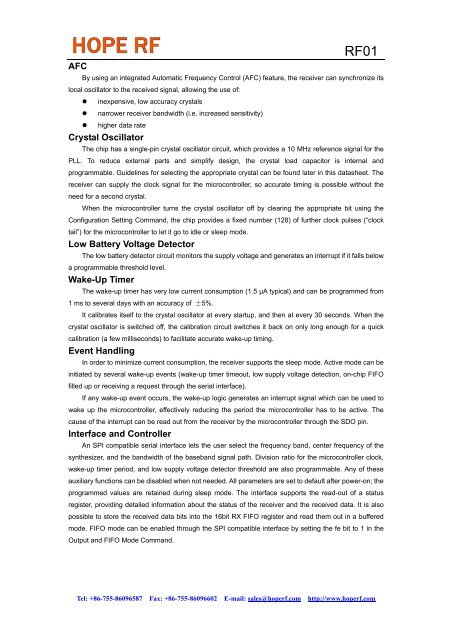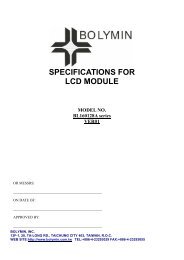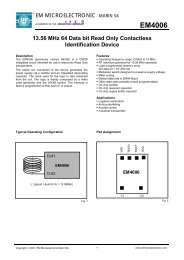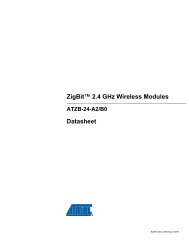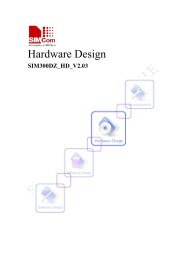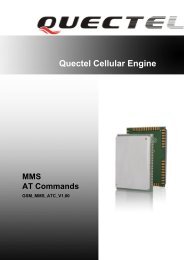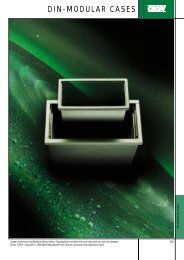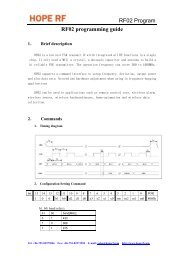RF01 Universal ISM Band FSK Receiver
RF01 Universal ISM Band FSK Receiver
RF01 Universal ISM Band FSK Receiver
- No tags were found...
You also want an ePaper? Increase the reach of your titles
YUMPU automatically turns print PDFs into web optimized ePapers that Google loves.
AFC<strong>RF01</strong>By using an integrated Automatic Frequency Control (AFC) feature, the receiver can synchronize itslocal oscillator to the received signal, allowing the use of:• inexpensive, low accuracy crystals• narrower receiver bandwidth (i.e. increased sensitivity)• higher data rateCrystal OscillatorThe chip has a single-pin crystal oscillator circuit, which provides a 10 MHz reference signal for thePLL. To reduce external parts and simplify design, the crystal load capacitor is internal andprogrammable. Guidelines for selecting the appropriate crystal can be found later in this datasheet. Thereceiver can supply the clock signal for the microcontroller, so accurate timing is possible without theneed for a second crystal.When the microcontroller turns the crystal oscillator off by clearing the appropriate bit using theConfiguration Setting Command, the chip provides a fixed number (128) of further clock pulses (“clocktail”) for the microcontroller to let it go to idle or sleep mode.Low Battery Voltage DetectorThe low battery detector circuit monitors the supply voltage and generates an interrupt if it falls belowa programmable threshold level.Wake-Up TimerThe wake-up timer has very low current consumption (1.5 µA typical) and can be programmed from1 ms to several days with an accuracy of ±5%.It calibrates itself to the crystal oscillator at every startup, and then at every 30 seconds. When thecrystal oscillator is switched off, the calibration circuit switches it back on only long enough for a quickcalibration (a few milliseconds) to facilitate accurate wake-up timing.Event HandlingIn order to minimize current consumption, the receiver supports the sleep mode. Active mode can beinitiated by several wake-up events (wake-up timer timeout, low supply voltage detection, on-chip FIFOfilled up or receiving a request through the serial interface).If any wake-up event occurs, the wake-up logic generates an interrupt signal which can be used towake up the microcontroller, effectively reducing the period the microcontroller has to be active. Thecause of the interrupt can be read out from the receiver by the microcontroller through the SDO pin.Interface and ControllerAn SPI compatible serial interface lets the user select the frequency band, center frequency of thesynthesizer, and the bandwidth of the baseband signal path. Division ratio for the microcontroller clock,wake-up timer period, and low supply voltage detector threshold are also programmable. Any of theseauxiliary functions can be disabled when not needed. All parameters are set to default after power-on; theprogrammed values are retained during sleep mode. The interface supports the read-out of a statusregister, providing detailed information about the status of the receiver and the received data. It is alsopossible to store the received data bits into the 16bit RX FIFO register and read them out in a bufferedmode. FIFO mode can be enabled through the SPI compatible interface by setting the fe bit to 1 in theOutput and FIFO Mode Command.Tel: +86-755-86096587 Fax: +86-755-86096602 E-mail: sales@hoperf.com http://www.hoperf.com


